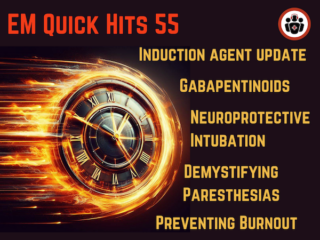EM Quick Hits 55 – Induction Agents, Gabapentinoids, Neuroprotective Intubation, Approach to Paresthesias, Preventing Burnout
Anand Swaminathan on an update on the appropriate selection of induction agents. Hans Rosenberg on when to use gabapentinoids for pain control in the ED. Katie Lin on pearls for neuroprotective intubation. Nour Khatib and Hamza Jalal on an approach to paresthesias in the ED. Eric Wortmann on preventing burnout in emergency medicine. Please support EM Cases with a donation https://emergencymedicinecases.com/donation/





